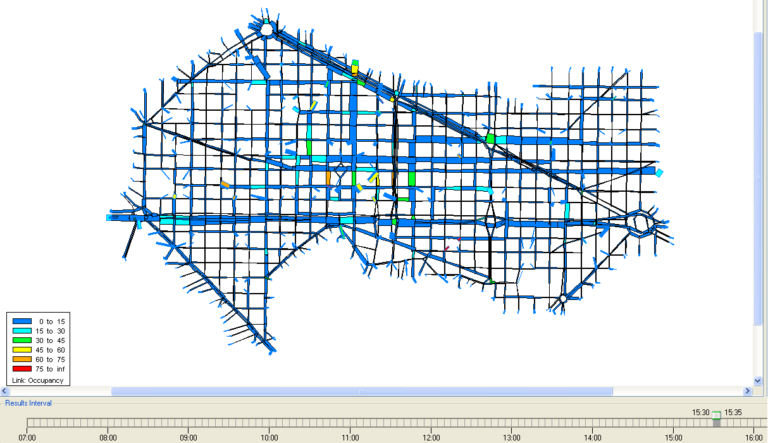In4Mo. Advanced Information System for the Mobility of People and Vehicles
- AMPL, C++, CPLEX, Hibernate, HTML, Java, JBoss, JPA, JQuery, Matlab, PostGIS, PostgreSQL, R, Simulador Aimsun, Dynameq Simulator
Home » Success Stories »
Description
El proyecto In4Mo ha tenido como objetivo principal el desarrollo de las aplicaciones que constituyen el núcleo de la Smart Mobility, uno de los pilares fundamentales del concepto de Smart City: la provisión de información para los sistemas de información de tráfico, en cualquiera de sus formas, y en especial la de los “personal journey planners” y los sistemas de Gestión Activa del Tráfico, que permiten que el responsable de la gestión de la red vial pueda tener una visión y estimación adecuadas del estado de la red vial y de su evolución plausible a corto plazo, para tomar decisiones más eficientes.
In4Mo ha sido diseñando y desarrollado en función de escenarios tecnológicos previsibles en el corto-medio plazo, donde coexisten las tecnologías tradicionales de detección de tráfico (por ejemplo las espiras de inducción magnética) con las tecnologías emergentes (por ejemplo, magnetómetros), entre las que tienen un papel relevante las TIC (Bluetooth, GPS…) cuyas penetraciones y tendencias de penetración permiten contar con ellas para desarrollar sistemas más eficientes.
La tesis fundamental de In4Mo es que la tecnología, es decir la sensorización de la ciudad, es una condición necesaria, pero no suficiente, para la generación de información fiable, puntual y de valor añadido, es decir disponible en el lugar y el instante en que es necesaria, en otros términos, que el grado de “smartness” es resultado combinación eficiente de datos y su procesamiento.
Pero los datos proporcionados por las medidas de sensores de diferentes tecnologías son heterogéneos por lo cual la actividad innovadora primordial de In4Mo ha sido la propuesta de una metodología para el Filtrado, Fusión y Compleción de datos que incorpora e integra una variedad de métodos de análisis y procesamiento, flexibles y eficientes, que constituyen un producto que sustenta una plataforma básica para el suministro de los datos homogéneos y consistentes que alimentan los modelos para la información y la gestión del tráfico desde cualquier centro de control:
Técnicas de filtrado (no lineal, de filtro de Kalman…) que generen secuencias completas, consistentes y robustas por eliminación de datos atípicos y de compleción de datos faltantes para generar series completas.
Técnicas de fusión (Bayesianas, de redes neuronales, de modelos de tráfico…) que permitan combinar de manera coherente datos de fuentes heterogéneas para generar una información homogénea de mayor calidad que la de cada una de ellas individualmente.
Técnicas de estimación de estado (modelos de estimación de estado) y de predicción que permitan efectuar una estimación del estado del sistema de tráfico y la prognosis de su evolución plausible en un horizonte temporal de corto plazo.
La disponibilidad de datos de tráfico procedentes de sensores TIC permite una mejora sustancial en la calidad de la información de tráfico con respecto a la que generan los sistemas actualmente operativos; sin embargo, aún tardaremos bastante tiempo hasta que la penetración de las tecnologías TIC sea suficiente para proporcionar sólo por sí misma una imagen completa del estado del tráfico en la totalidad de la red vial, en particular en las que corresponden a áreas urbanas de tamaño medio o grande. Especialmente cuando las aplicaciones que tiene que soportar el sistema de información requieren el cálculo en tiempo real de caminos entre pares origen-destino cualesquiera como ocurre en el caso de los sistemas de navegación completos, o los de planificación de viajes que no tienen que restringirse a conjuntos de caminos predeterminados (por importantes que sean). En consecuencia la generación de información completa y consistente requiere la utilización de modelos dinámicos de tráfico que permitan una estimación global del estado de la red vial y predecir su evolución a corto plazo en ausencia de incidentes. In4Mo ha propuesto dos modelos dinámicos de tráfico complementarios:
Modelos para la estimación de Matrices Origen-Destino (OD) dependientes del tiempo, basados en la explotación de las medidas de variables de tráfico proporcionadas por las aplicaciones TIC, mediante versiones ad hoc de Filtros de Kalman.
Modelos que describen la dinámica de la propagación de los flujos de tráfico a través de la red vial en función de los patrones temporales de la demanda definidos por las matrices OD dependientes del tiempo.
La constatación de que, la misma información generada por la combinación de datos fusionados y modelos de tráfico, es la que necesita el responsable de la gestión del tráfico para gestionar una red vial, se traducido en In4Mo en una propuesta innovadora para la Smart Mobility: la gestión activa basada en el Macro Fundamental Diagram (MFD).
Una extensión a redes viales de concepto de diagrama fundamental del tráfico que permite estimar la capacidad de una red, de manera que la información disponible permite identificar en que zona del MFD se está operando y tomar las decisiones de restringir accesos (Gate-In), facilitar la evacuación (Gate-Out) o proponer (o imponer) rutas alternativas.
Este proyecto pertenece al programa Acción Estratégica de Telecomunicaciones y Sociedad de la Información, 2010. Subprograma: Avanza Competitividad I+D+I, (2010-2012)
5649
Articles and presentations
J.Barceló, F. Gilliéron, M.P. Linares, O. Serch, L.Montero, The detection layout problem. Paper 12-2056, accepted for publication in Transportation Research Records: Journal of the Transportation Research Board, to appear in 2012.
J.Barceló, L.Montero, M.Bullejos, O. Serch and C. Carmona, A Kalman Filter Approach for the Estimation of Time Dependent OD Matrices Exploiting Bluetooth Traffic Data Collection, Paper #12-3843, presented at the 91st TRB Annual Meeting, January 2012, included in the Compendium of Papers.
J.Barceló, L.Montero, L. Marqués and C. Carmona, Travel time forecasting and dynamic of estimation in freeways based on Bluetooth traffic monitoring, Transportation Research Records: Journal of the Transportation Research Board, Vol. 2175 (2010), pp. 19-2
[CAT] "Un equip de la UPC desenvolupa un sistema per una millor gestió de la mobilitat" – Video at XipTV
